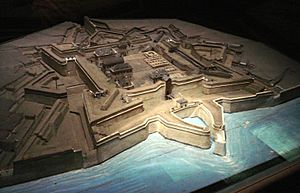Siege of Saint-Martin-de-Ré facts for kids
Quick facts for kids Siege of Saint-Martin-de-Ré(Siège de Saint-Martin-de-Ré) |
|||||||
|---|---|---|---|---|---|---|---|
| Part of the Anglo-French War (1627–1629) | |||||||
  Top: Full map of the landing, siege and retreat by the English forces of Buckingham. Bottom: The fortress of Saint-Martin. Military mock-up, 1702. Musée des Plans-Reliefs. |
|||||||
|
|||||||
| Belligerents | |||||||
| Commanders and leaders | |||||||
Toiras (commander) |
|||||||
| Strength | |||||||
| Initially: 100 ships 6,000 English soldiers 1,000 horses 4 cannons La Rochelle volunteers: 800 Reinforcements: 2,000 Irish soldiers 400 raw troops |
Initially: 1,200 men 200 horsemen Reinforcements: 4,000 men (October) |
||||||
| Casualties and losses | |||||||
| around 5,000 | around 500 | ||||||
The siege of Saint-Martin-de-Ré was a battle in 1627. It was an attempt by English forces to capture the French fortress-city of Saint-Martin-de-Ré. This city is located on the island of Île de Ré, near La Rochelle.
The English forces were led by George Villiers, the Duke of Buckingham. After three months of fighting, the French, led by the Marquis de Toiras, won. The Duke of Buckingham had to retreat. This battle was the start of the Anglo-French War of 1627–1629.
Contents
The English Landing
On July 12, 1627, an English force arrived. It had 100 ships and 6,000 soldiers. They sailed from Plymouth Sound and landed on the Île de Ré. Their goal was to control the area near La Rochelle. They also hoped to encourage a rebellion in the city.
The English landed at Sablanceau beach. The Duke of Buckingham wanted to capture Fort of La Prée. He also wanted to take the fortified city of Saint-Martin-de-Ré.
A French force of 1,200 soldiers and 200 horsemen was on the island. They were led by the Marquis de Toiras, the island's Governor. They tried to stop the English landing. But the English managed to set up their camp on the beach. Over 100 English soldiers were killed.
For three days, Buckingham worked to secure his position. Toiras gathered all the food and supplies on the island. He then went into the citadel of Saint Martin to defend it. Buckingham tried to surround the citadel. But this was difficult. The English engineer who planned the siege had drowned. They also had too few cannons, and they were too small. As autumn came, many English soldiers got sick. The siege continued until October.
Help Arrives
The English needed more supplies from England. But not enough help arrived. Two thousand Irish soldiers came on September 3, 1627. A small supply fleet brought only 400 new soldiers.
A Scottish fleet with 30 ships and 5,000 men was on its way. But a storm broke it up in October 1627. A large relief fleet from England left too late, on November 6, 1627.
The French also had difficulties. But they managed to get some supplies to the defenders. In August, Cardinal Richelieu offered a reward. He would give 30,000 French coins to the first ship captain. This captain had to deliver 50 barrels of food to the citadel.
Finally, a large French supply fleet arrived on October 7-8. Twenty-nine out of 35 ships got past the English blockade. This was just in time. Toiras had said he could not hold out much longer.
From the French mainland, 4,000 more soldiers landed. They arrived on the southern part of the island on October 20. These rescue troops were led by Marshal of France Henri de Schomberg.
Last Attack and Retreat
On October 27, Buckingham tried one last attack on Saint Martin. But the English ladders were too short to climb the walls. The fortress could not be taken.
The French soldiers inside the fortress were also very tired. But Buckingham decided to retreat. He led his troops to the northern part of the island. They planned to leave from the area of Loix. French troops chased them, causing many English casualties. In total, Buckingham lost more than 5,000 men in the campaign. He had started with 7,000.
What Happened Next
Two months after the siege began, the people of La Rochelle started fighting the French government. This led to the siege of La Rochelle.
After Buckingham's defeat, England tried to send two fleets to help La Rochelle. The first fleet left in April 1628. It was led by William Feilding. But it returned without fighting. Denbigh said he was not allowed to risk the king's ship.
Buckingham tried to plan another campaign to help La Rochelle. But he was killed in Portsmouth on August 23, 1628. An army officer, John Felton, was responsible. Felton had been hurt in an earlier battle. He felt Buckingham had not promoted him. Felton was later hanged. Buckingham was buried in Westminster Abbey. Many people disliked Buckingham at the time. Felton was seen as a hero by some.
The second English fleet left soon after Buckingham's death. It was led by the Earl of Lindsey. But it could not get past the seawall in front of La Rochelle. La Rochelle was exhausted and had no hope of help. It surrendered to French forces on October 28.
After these defeats, England made peace with France in 1629. They also made peace with Spain in 1630. This ended England's part in the Thirty Years War.
The main port of Saint Martin was made even stronger in 1681. This was done by a famous engineer named Vauban.
Images for kids
-
The Duke of Buckingham had to retreat in defeat.
-
The Governor of Île de Ré (and future Marshal of France) Toiras led the defense of Saint-Martin-de-Ré. Versailles.
-
Map of Saint-Martin-de-Ré, with fortress (left) and city (right), 17th century, before the enlarged fortifications around the city by Vauban in 1681.
See also










